Response of Alfalfa Leaf Traits and Rhizosphere Fungal Communities to Compost Application in Saline–Sodic Soil
Abstract
:1. Introduction
2. Materials and Methods
2.1. Pot Experiment Setup and Sample Collection
2.2. Measurement of Plant Traits and Soil Properties
2.3. Sequence Processing and Bioinformatics Analysis
2.4. Statistical Analysis
3. Results
3.1. Soil Properties and Plant Traits
3.2. Illumina Run Metrics
3.3. Rhizosphere Fungal Community Composition and Diversity
3.4. Linkages Between Rhizosphere Fungal Community and Soil Environmental Factors
3.5. Relationships Between Rhizosphere Fungal Communities and Plant Traits
3.6. Prediction Potential Functions of Rhizosphere Fungal Communities
4. Discussion
4.1. Compost Enhanced Plant Adaptability to Sodic-Alkaline Stress
4.2. Compost Induced Alfalfa to Recruit Specific Rhizosphere Fungal Communities
4.3. Compost Mediated Rhizosphere Fungal Community–Soil–Plant Interactions
5. Conclusions
Supplementary Materials
Author Contributions
Funding
Data Availability Statement
Conflicts of Interest
References
- Julkowska, M.M.; Testerink, C. Tuning plant signaling and growth to survive salt. Trends Plant Sci. 2015, 20, 586–594. [Google Scholar] [CrossRef]
- Wang, M.; Rengasamy, P.; Wang, Z.; Yang, F.; Ma, H.; Huang, L.; Liu, M.; Yang, H.; Li, J.; An, F.; et al. Identification of the most limiting factor for rice yield using soil data collected before planting and during the reproductive stage. Land Degrad. Dev. 2018, 29, 2310–2320. [Google Scholar] [CrossRef]
- Wei, T.-J.; Li, G.; Wang, M.-M.; Jin, Y.-Y.; Zhang, G.-H.; Liu, M.; Yang, H.-Y.; Jiang, C.-J.; Liang, Z.-W. Physiological and tran-scriptomic analyses reveal novel insights into the cultivar-specific response to alkaline stress in alfalfa (Medicago sativa L.). Ecotox. Environ. Saf. 2021, 228, 113017. [Google Scholar] [CrossRef]
- Wei, T.-J.; Jiang, C.-J.; Jin, Y.-Y.; Zhang, G.-H.; Wang, M.-M.; Liang, Z.-W. Ca2+/Na+ Ratio as a critical marker for field evaluation of saline-alkaline tolerance in alfalfa (Medicago sativa L.). Agronomy 2020, 10, 191. [Google Scholar] [CrossRef]
- Zhao, B.; Wang, Y.; Ma, L.; Li, Y.; Deng, Y.; Chen, X.; Xu, Z. Adding an appropriate proportion of phosphogypsum ensured rice husk and urea composting to promote the compost as substrate utilization. Bioresour. Technol. 2022, 344, 126301. [Google Scholar] [CrossRef]
- Shen, Q.; Sun, H.; Yao, X.; Wu, Y.; Wang, X.; Chen, Y.; Tang, J. A comparative study of pig manure with different waste straws in an ectopic fermentation system with thermophilic bacteria during the aerobic process: Performance and microbial community dynamics. Bioresour. Technol. 2019, 281, 202–208. [Google Scholar] [CrossRef]
- Alromian, F.M. Effect of type of compost and application rate on growth and quality of lettuce plant. J. Plant Nutr. 2020, 43, 2797–2809. [Google Scholar] [CrossRef]
- Siedt, M.; Schäffer, A.; Smith, K.E.C.; Nabel, M.; Roß-Nickoll, M.; van Dongen, J.T. Comparing straw, compost, and biochar regarding their suitability as agricultural soil amendments to affect soil structure, nutrient leaching, microbial communities, and the fate of pesticides. Sci. Total Environ. 2021, 751, 141607. [Google Scholar] [CrossRef]
- Goldan, E.; Nedeff, V.; Barsan, N.; Culea, M.; Panainte-Lehadus, M.; Mosnegutu, E.; Tomozei, C.; Chitimus, D.; Irimia, O. Assessment of manure compost used as soil amendment—A Review. Processes 2023, 11, 1167. [Google Scholar] [CrossRef]
- Savy, D.; Cozzolino, V.; Vinci, G.; Verrillo, M.; Aliberti, A.; Maggio, A.; Barone, A.; Piccolo, A. Fertilisation with compost mitigates salt stress in tomato by affecting plant metabolomics and nutritional profiles. Chem. Biol. Technol. Agric. 2022, 9, 104. [Google Scholar] [CrossRef]
- Xu, D.; Yu, X.; Chen, J.; Li, X.; Chen, J.; Li, J. Effects of compost as a soil amendment on bacterial community diversity in saline–alkali soil. Front. Microbiol. 2023, 14, 1253415. [Google Scholar] [CrossRef]
- Massaccesi, L.; Nogués, I.; Mazzurco Miritana, V.; Passatore, L.; Zacchini, M.; Pietrini, F.; Carloni, S.; Marabottini, R.; Moscatelli, M.C.; Marinari, S. Short-term effects of biochar and compost on soil microbial community, C and N cycling, and lettuce (Lactuca sativa L.) yield in a Mediterranean environment. Appl. Soil Ecol. 2024, 199, 105411. [Google Scholar] [CrossRef]
- Yao, R.; Yang, J.; Zhu, W.; Li, H.; Yin, C.; Jing, Y.; Wang, X.; Xie, W.; Zhang, X. Impact of crop cultivation, nitrogen and fulvic acid on soil fungal community structure in salt-affected alluvial fluvo-aquic soil. Plant Soil 2021, 464, 539–558. [Google Scholar] [CrossRef]
- Gao, X.; Guo, H.; Zhang, Q.; Guo, H.; Zhang, L.; Zhang, C.; Gou, Z.; Liu, Y.; Wei, J.; Chen, A.; et al. Arbuscular mycorrhizal fungi (AMF) enhanced the growth, yield, fiber quality and phosphorus regulation in upland cotton (Gossypium hirsutum L.). Sci. Rep. 2020, 10, 2084. [Google Scholar] [CrossRef]
- Chang, J.; Sun, Y.; Tian, L.; Ji, L.; Luo, S.; Nasir, F.; Kuramae, E.E.; Tian, C. The structure of rhizosphere fungal communities of wild and do-mesticated rice: Changes in diversity and co-occurrence patterns. Front. Microbiol. 2021, 12, 610823. [Google Scholar] [CrossRef]
- Pant, P.; Negi, A.; Rawat, J.; Kumar, R. Characterization of rhizospheric fungi and their in vitro antagonistic potential against myco-phytopathogens invading Macrotyloma uniflorum plants. Int. Microbiol. 2024, 1–19. [Google Scholar] [CrossRef]
- Ajith, P.; Lakshmidevi, N. Zygosporium masonii: A new fungal antagonist against colletotrichum capsici incitant of anthracnose on bellpeppers. J. Agric. Sci. Technol.-Iran 2012, 8, 931–939. [Google Scholar]
- Hartmann, M.; Frey, B.; Mayer, J.; Mäder, P.; Widmer, F. Distinct soil microbial diversity under long-term organic and conventional farming. ISME J. 2014, 9, 1177–1194. [Google Scholar] [CrossRef]
- Du, J.; Yu, Y.; Tang, C.; Zong, K.; Zhang, S.; Zhang, Q.; Fang, L.; Li, Y. Organic fertilizers increase the proportion of saprotrophs favoring soil nitrification under medicinal plants Fritillaria thunbergii. Ind. Crops Prod. 2024, 219, 119129. [Google Scholar] [CrossRef]
- Wei, Y.; Zhang, S.-H. Haloalkaliphilic Fungi and Their Roles in the Treatment of Saline-Alkali Soil, in Fungi in Extreme Environments: Ecological Role and Biotechnological Significance; Tiquia-Arashiro, S.M., Grube, M., Eds.; Springer International Publishing: Cham, Switzerland, 2019; pp. 535–557. [Google Scholar] [CrossRef]
- Kuvarina, A.E.; Georgieva, M.L.; Rogozhin, E.A.; Kulko, A.B.; Gavryushina, I.A.; Sadykova, V.S. Antimicrobial potential of the alkalophilic fungus sodiomyces alkalinus and selection of strains–producers of new antimicotic compound. Appl. Biochem. Microbiol. 2021, 57, 86–93. [Google Scholar] [CrossRef]
- Bondarenko, S.A.; Ianutsevich, E.A.; Danilova, O.A.; Grum-Grzhimaylo, A.A.; Kotlova, E.R.; Kamzolkina, O.V.; Bilanenko, E.N.; Tereshina, V.M. Mem-brane lipids soluble sugars dynamics of the alkaliphilic fungus Sodiomyces tronii in response to ambient, p.H. Extremophiles 2017, 21, 743–754. [Google Scholar] [CrossRef] [PubMed]
- Li, X.; Zhang, T.; Xue, Y.; Xu, X.; Cui, X.; Fu, J. Aspergillus aculeatus enhances nutrient uptake and forage quality in bermudagrass by increasing phosphorus and potassium availability. Front. Plant Sci. 2023, 14, 1165567. [Google Scholar] [CrossRef]
- Hung, R.; Rutgers, S.L. Chapter 17—Applications of Aspergillus in Plant Growth Promotion. In New and Future Developments in Microbial Biotechnology and Bioengineering; Gupta, V.K., Ed.; Elsevier: Amsterdam, The Netherlands, 2016; pp. 223–227. [Google Scholar]
- Daigham, G.E.; Mahfouz, A.Y.; Abdelaziz, A.M.; Nofel, M.M.; Attia, M.S. Protective role of plant growth-promoting fungi Aspergillus chevalieri OP593083 and Aspergillus egyptiacus OP593080 as biocontrol approach against Alternaria leaf spot disease of Vicia faba plant. Biomass Conv. Bioref. 2024, 14, 23073–23089. [Google Scholar] [CrossRef]
- Semenov, M.V.; Krasnov, G.S.; Semenov, V.M.; van Bruggen, A. Mineral and organic fertilizers distinctly affect fungal communities in the crop rhizosphere. J. Fungi 2022, 8, 251. [Google Scholar] [CrossRef]
- Ding, J.; Jiang, X.; Guan, D.; Zhao, B.; Ma, M.; Zhou, B.; Cao, F.; Yang, X.; Li, L.; Li, J. Influence of inorganic fertilizer and organic manure application on fungal communities in a long-term field experiment of Chinese Mollisols. Appl. Soil Ecol. 2017, 111, 114–122. [Google Scholar] [CrossRef]
- Xiang, X.; Liu, J.; Zhang, J.; Li, D.; Xu, C.; Kuzyakov, Y. Divergence in fungal abundance and community structure between soils under long-term mineral and organic fertilization. Soil Till. Res. 2020, 196, 104491. [Google Scholar] [CrossRef]
- Wright, I.J.; Reich, P.B.; Westoby, M.; Ackerly, D.D.; Baruch, Z.; Bongers, F.; Cavender-Bares, J.; Chapin, T.; Cornelissen, J.H.C.; Diemer, M.; et al. The worldwide leaf economics spectrum. Nature 2004, 428, 821–827. [Google Scholar] [CrossRef]
- Leishman, M.R.; Haslehurst, T.; Ares, A.; Baruch, Z. Leaf trait relationships of native and invasive plants: Community- and global-scale comparisons. New Phytol. 2007, 176, 635–643. [Google Scholar] [CrossRef]
- Klumpp, K.; Soussana, J.-F. Using functional traits to predict grassland ecosystem change: A mathematical test of the re-sponse-and-effect trait approach. Glob. Change Biol. 2009, 15, 2921–2934. [Google Scholar] [CrossRef]
- Chiappero, J.; Cappellari, L.d.R.; Sosa Alderete, L.G.; Palermo, T.B.; Banchio, E. Plant growth promoting rhizobacteria improve the antioxidant status in Mentha piperita grown under drought stress leading to an enhancement of plant growth and total phenolic content. Ind. Crops Prod. 2019, 139, 111553. [Google Scholar] [CrossRef]
- Mikiciuk, G.; Sas-Paszt, L.; Mikiciuk, M.; Derkowska, E.; Trzciński, P.; Głuszek, S.; Lisek, A.; Wera-Bryl, S.; Rudnicka, J. Mycorrhizal frequency, physiological parameters, and yield of strawberry plants inoculated with endomycorrhizal fungi and rhizosphere bacteria. Mycorrhiza 2019, 29, 489–501. [Google Scholar] [CrossRef] [PubMed]
- Yan, H.; Cong, M.; Hu, Y.; Qiu, C.; Yang, Z.; Tang, G.; Xu, W.; Zhu, X.; Sun, X.; Jia, H. Biochar-mediated changes in the microbial communities of rhizosphere soil alter the architecture of maize roots. Front. Microbiol. 2022, 13, 1023444. [Google Scholar] [CrossRef]
- Luo, T.; Min, T.; Ru, S.; Li, J. Response of cotton root growth and rhizosphere soil bacterial communities to the application of acid compost tea in calcareous soil. Appl. Soil Ecol. 2022, 177, 104523. [Google Scholar] [CrossRef]
- Neemisha Sharma, S. Soil Enzymes and Their Role in Nutrient Cycling, in Structure and Functions of Pedosphere; Giri, B., Ed.; Springer Nature Singapore: Singapore, 2022; pp. 173–188. [Google Scholar] [CrossRef]
- Liu, G.; Wang, H.; Yan, G.; Wang, M.; Jiang, S.; Wang, X.; Xue, J.; Xu, M.; Xing, Y.; Wang, Q. Soil enzyme activities and microbial nutrient limitation during the secondary succession of boreal forests. CATENA 2023, 230, 107268. [Google Scholar] [CrossRef]
- Wu, Z.; Han, X.; Chen, X.; Lu, X.; Yan, J.; Wang, W.; Zou, W.; Yan, L. Application of organic manure as a potential strategy to alleviate the limitation of microbial resources in soybean rhizospheric bulk soils. J. Integr. Agric. 2024, 23, 2065–2082. [Google Scholar] [CrossRef]
- Adetunji, A.T.; Lewu, F.B.; Mulidzi, R.; Ncube, B. The biological activities of β-glucosidase, phosphatase and urease as soil quality indicators: A review. J. Soil Sci. Plant Nutr. 2017, 17, 794–807. [Google Scholar] [CrossRef]
- Mazumder, P.; Pm, A.; Jyoti Khwairakpam, M.; Mishra, U.; Kalamdhad, A.S. Enhancement of soil physico-chemical properties post compost application: Optimization using Response Surface Methodology comprehending Central Composite Design. J. Environ. Manag. 2021, 289, 112461. [Google Scholar] [CrossRef]
- Munns, R.; Tester, M. Mechanisms of Salinity Tolerance. Annu. Rev. Plant Biol. 2008, 59, 651–681. [Google Scholar] [CrossRef]
- Liu, L.; Wang, S.; Guo, X.; Wang, H. Comparison of the effects of different maturity composts on soil nutrient, plant growth and heavy metal mobility in the contaminated soil. J. Environ. Manag. 2019, 250, 109525. [Google Scholar] [CrossRef]
- Chmara, R.; Pronin, E. Intraspecific leaf trait variation of the heterophyllous amphibious plant Luronium natans: A trait-based study. Hydrobiologia 2024, 1–12. [Google Scholar] [CrossRef]
- Bolyen, E.; Rideout, J.R.; Dillon, M.R.; Bokulich, N.A.; Abnet, C.; Al-Ghalith, G.A.; Alexander, H.; Alm, E.J.; Arumugam, M.; Asnicar, F.; et al. Author Correction: Reproducible, interactive, scalable and extensible microbiome data science using QIIME 2. Nat. Biotechnol. 2019, 37, 1091. [Google Scholar] [CrossRef] [PubMed]
- Martin, M. Cutadapt removes adapter sequences from high-throughput sequencing reads. EMBnet 2011, 17, 10–12. [Google Scholar] [CrossRef]
- Callahan, B.J.; McMurdie, P.J.; Rosen, M.J.; Han, A.W.; Johnson, A.J.A.; Holmes, S.P. DAD2: High-resolution sample inference from illumina amplicon data. Nat. Methods 2016, 13, 581–583. [Google Scholar] [CrossRef]
- Price, M.N.; Dehal, P.S.; Arkin, A.P. FastTree: Computing large minimum evolution trees with profiles instead of a distance matrix. Mol. Biol. Evol. 2009, 26, 1641–1650. [Google Scholar] [CrossRef]
- Bokulich, N.A.; Kaehler, B.D.; Rideout, J.R.; Dillon, M.; Boylen, E.; Knight, R.; Huttley, G.A.; Caporaso, J.G. Optimizing taxonomic classification of marker-gene amplicon sequences with QIIME 2’s q2-feature-classifier plugin. Microbiome 2018, 6, 90. [Google Scholar] [CrossRef]
- Kõljalg, U.; Nilsson, R.H.; Abarenkov, K.; Tedersoo, L.; Taylor, A.F.; Bahram, M.; Bates, S.T.; Bruns, T.D.; Bengtsson-Palme, J.; Callaghan, T.M.; et al. Towards a unified paradigm for sequence-based identification of fungi. Mol. Ecol. 2013, 22, 5271–5277. [Google Scholar] [CrossRef] [PubMed]
- Love, M.I.; Huber, W.; Anders, S. Moderated estimation of fold change and dispersion for RNA-seq data with DESeq2. Genome Biol. 2014, 15, 550. [Google Scholar] [CrossRef]
- Nguyen, N.H.; Song, Z.; Bates, S.T.; Branco, S.; Tedersoo, L.; Menke, J.; Schilling, J.S.; Kennedy, P.G. FUNGuild: An open annotation tool for parsing fungal community datasets by ecological guild. Fungal Ecol. 2016, 20, 241–248. [Google Scholar] [CrossRef]
- Mao, X.; Yang, Y.; Guan, P.; Geng, L.; Ma, L.; Di, H.; Liu, W.; Li, B. Remediation of organic amendments on soil salinization: Focusing on the relationship between soil salts and microbial communities. Ecotox. Environ. Saf. 2022, 239, 113616. [Google Scholar] [CrossRef]
- Tejada, M.; Gonzalez, J.L. Crushed cotton gin compost on soil biological properties and rice yield. Eur. J. Agron. 2006, 25, 22–29. [Google Scholar] [CrossRef]
- Oo, A.N.; Iwai, C.B.; Saenjan, P. Soil Properties and Maize Growth in Saline and Nonsaline Soils using Cassava-Industrial Waste Compost and Vermicompost with or Without Earthworms. Land Degrad. Dev. 2015, 26, 300–310. [Google Scholar] [CrossRef]
- Ryals, R.; Silver, W.L. Effects of organic matter amendments on net primary productivity and greenhouse gas emissions in annual grasslands. Ecol. Appl. 2013, 23, 46–59. [Google Scholar] [CrossRef]
- Wei, W.; Yan, Y.; Cao, J.; Christie, P.; Zhang, F.; Fan, M. Effects of combined application of organic amendments and fertilizers on crop yield and soil organic matter: An integrated analysis of long-term experiments. Agric. Ecosyst. Environ. 2016, 225, 86–92. [Google Scholar] [CrossRef]
- Toju, H.; Kishida, O.; Katayama, N.; Takagi, K. Networks depicting the fine-scale co-occurrences of fungi in soil horizons. PLoS ONE 2016, 11, e0165987. [Google Scholar] [CrossRef]
- Beimforde, C.; Feldberg, K.; Nylinder, S.; Rikkinen, J.; Tuovila, H.; Dörfelt, H.; Gube, M.; Jackson, D.J.; Reitner, J.; Seyfullah, L.J.; et al. Estimating the Phanerozoic history of the Ascomycota lineages: Combining fossil and molecular data. Mol. Phylogenet. Evol. 2014, 78, 386–398. [Google Scholar] [CrossRef]
- Zhou, J.; Jiang, X.; Zhou, B.; Zhao, B.; Ma, M.; Guan, D.; Li, J.; Chen, S.; Cao, F.; Shen, D.; et al. Thirty four years of nitrogen fertilization decreases fungal di-versity and alters fungal community composition in black soil in northeast China. Soil Biol. Biochem. 2016, 95, 135–143. [Google Scholar] [CrossRef]
- Bardgett, R.D.; van der Putten, W.H. Belowground biodiversity and ecosystem functioning. Nature 2014, 515, 505–511. [Google Scholar] [CrossRef] [PubMed]
- Van der Heijden, M.G.; Bardgett, R.D.; van Straalen, N.M. The unseen majority: Soil microbes as drivers of plant diversity and productivity in terrestrial ecosystems. Ecol. Lett. 2008, 11, 296–310. [Google Scholar] [CrossRef]
- Grum-Grzhimaylo, A.; Debets Av Van Diepeningen, A.; Georgieva, M.; Bilanenko, E. Sodiomyces alkalinus, a new holomorphic alkaliphilic ascomycete within the Plectosphaerellaceae. Persoonia-Mol. Phylogeny Evol. Fungi 2013, 31, 147–158. [Google Scholar] [CrossRef]
- Li, R.; Sun, B.; Song, M.; Yan, G.; Hu, Q.; Bai, Z.; Wang, J.; Zhuang, X. Improvement of saline soil properties and Brassica rapa L. growth using biofertilizers. Sustainability 2024, 16, 2196. [Google Scholar] [CrossRef]
- Bondarenko, S.A.; Ianutsevich, E.A.; Sinitsyna, N.A.; Georgieva, M.L.; Bilanenko, E.N.; Tereshina, B.M. Dynamics of the cytosol soluble carbohydrates and membrane lipids in response to ambient pH in alkaliphilic and alkalitolerant fungi. Microbiology 2018, 87, 21–32. [Google Scholar] [CrossRef]
- Bonanomi, G.; Lorito, M.; Vinale, F.; Woo, S.L. Organic amendments, beneficial microbes, and soil microbiota: Toward a unified framework for disease suppression. Annu. Rev. Phytopathol. 2018, 56, 1–20. [Google Scholar] [CrossRef]
- Rauwane, M.E.; Ogugua, U.V.; Kalu, C.M.; Ledwaba, L.K.; Woldesemayat, A.A.; Ntushelo, K. Pathogenicity and Virulence Factors of Fusarium graminearum Including Factors Discovered Using Next Generation Sequencing Technologies and Pro-teomics. Microorganisms 2020, 8, 305. [Google Scholar] [CrossRef]
- Raimondo, M.L.; Carlucci, A. Characterization and pathogenicity assessment of Plectosphaerella species associated with stunting disease on tomato and pepper crops in Italy. Plant Pathol. 2018, 67, 626–641. [Google Scholar] [CrossRef]
- Mehta, C.M.; Palni, U.; Franke-Whittle, I.H.; Sharma, A.K. Compost: Its role, mechanism and impact on reducing soil-borne plant diseases. Waste Manag. 2014, 34, 607–622. [Google Scholar] [CrossRef]
- Jin, X.; Cai, J.; Yang, S.; Li, S.; Shao, X.; Fu, C.; Li, C.; Deng, Y.; Huang, J.; Ruan, Y. Partial substitution of chemical fertilizer with organic fertilizer and slow-release fertilizer benefits soil microbial diversity and pineapple fruit yield in the tropics. Appl. Soil Ecol. 2023, 189, 104974. [Google Scholar] [CrossRef]
- Dang, Q.; Wang, Y.; Xiong, S.; Yu, H.; Zhao, X.; Tan, W.; Cui, D.; Xi, B. Untangling the response of fungal community structure, composition and function in soil aggregate fractions to food waste compost addition. Sci. Total Environ. 2021, 769, 145248. [Google Scholar] [CrossRef]
- Hernández, T.; Garcia, E.; García, C. A strategy for marginal semiarid degraded soil restoration: A sole addition of compost at a high rate. A five-year field experiment. Soil Biol. Biochem. 2015, 89, 61–71. [Google Scholar] [CrossRef]
- Schmidt, R.; Mitchell, J.; Scow, K. Cover cropping and no-till increase diversity and symbiotroph:saprotroph ratios of soil fungal communities. Soil Biol. Biochem. 2018, 129, 99–109. [Google Scholar] [CrossRef]
- Lekberg, Y.; Arnillas, C.A.; Borer, E.T.; Bullington, L.S.; Fierer, N.; Kennedy, P.G.; Leff, J.W.; Luis, A.D.; Seabloom, E.W.; Henning, J.A. Nitrogen and phosphorus fertilization consistently favor pathogenic over mutualistic fungi in grassland soils. Nat. Commun. 2021, 1, 3484. [Google Scholar] [CrossRef]
- Liu, X.; Shi, Y.; Kong, L.; Tong, L.; Cao, H.; Zhou, H.; Lv, Y. Long-term application of bio-compost increased soil microbial community diversity and altered its composition and network. Microorganisms 2022, 10, 462. [Google Scholar] [CrossRef] [PubMed]
- Chen, W.; Xu, R.; Wu, Y.; Chen, J.; Zhang, Y.; Hu, T.; Yuan, X.; Zhou, L.; Tan, T.; Fan, J. Plant diversity is coupled with beta not alpha diversity of soil fungal communities following N enrichment in a semi-arid grassland. Soil Biol. Biochem. 2018, 116, 388–398. [Google Scholar] [CrossRef]
- Gosling, P.; Mead, A.; Proctor, M.; Hammond, J.P.; Bending, G.D. Contrasting arbuscular mycorrhizal communities colonizing different host plants show a similar response to a soil phosphorus concentration gradient. New Phytol. 2013, 198, 546–556. [Google Scholar] [CrossRef]
- Sun, R.; Dsouza, M.; Gilbert, J.A.; Guo, X.; Wang, D.; Guo, Z.; Ni, Y.; Chu, H. Fungal community composition in soils subjected to long-term chemical fertilization is most influenced by the type of organic matter. Environ. Microbiol. 2016, 18, 5137–5150. [Google Scholar] [CrossRef] [PubMed]
- Liu, K.; Liu, Z.; Zhou, N.; Shi, X.; Lock, T.R.; Kallenbach, R.L.; Yuan, Z. Diversity-stability relationships in temperate grasslands as a function of soil pH. Land Degrad. Dev. 2022, 33, 1704–1717. [Google Scholar] [CrossRef]
- Howell, C.R.; Jenkins, S.N.; Abbott, L.K.; Mickan, B.S. Amelioration of a saline-alkaline soil using biochar and compost: Impacts on plant growth, soil biological and chemical characteristics. Land Degrad. Dev. 2024, 35, 142–155. [Google Scholar] [CrossRef]
- L Liu, J.; Sui, Y.; Yu, Z.; Shi, Y.; Chu, H.; Jin, J.; Liu, X.; Wang, G. Soil carbon content drives the biogeographical distribution of fungal communities in the black soil zone of northeast China. Soil Biol. Biochem. 2015, 83, 29–39. [Google Scholar] [CrossRef]
- Yan, Y.; Sun, X.; Sun, F.; Zhao, Y.; Sun, W.; Guo, J.; Zhang, T. Sensitivity of soil fungal and bacterial community compositions to nitrogen and phosphorus additions in a temperate meadow. Plant Soil 2022, 471, 477–490. [Google Scholar] [CrossRef]
- Liu, M.; Shen, Y.; Li, Q.; Xiao, W.; Song, X. Arbuscular mycorrhizal fungal colonization and soil pH induced by nitrogen and phosphorus additions affects leaf C:N:P stoichiometry in Chinese fir (Cunninghamia lanceolata) forests. Plant Soil 2021, 461, 421–440. [Google Scholar] [CrossRef]
- Amtmann, A.; Hammond, J.P.; Armengaud, P.; White, P.J. Nutrient Sensing and Signalling in Plants: Potassium and Phosphorus. In Advances in Botanical Research; Academic Press: Cambridge, MA, USA, 2005; pp. 209–257. [Google Scholar] [CrossRef]
- Bargaz, A.; Lyamlouli, K.; Chtouki, M.; Zeroual, Y.; Dhiba, D. Soil microbial resources for improving fertilizers efficiency in an integrated plant nutrient management system. Front. Microbiol. 2018, 9, 1606. [Google Scholar] [CrossRef]
- Prajapati, K.; Modi, H. Isolation and characterization of potassium solubilizing bacteria from ceramic industry soil. CIBTech J. Microbiol. 2012, 1, 8–14. [Google Scholar]
- Akanmu, A.O.; Babalola, O.O.; Venturi, V.; Ayilara, M.S.; Adeleke, B.S.; Amoo, A.E.; Sobowale, A.A.; Fadiji, A.E.; Glick, B.R. Plant Disease management: Lever-aging on the plant-microbe-soil interface in the biorational use of organic amendments. Front. Plant Sci. 2021, 12, 700507. [Google Scholar] [CrossRef] [PubMed]
- Abdul Qadir, A.; Alserae, H.; Raza, A.; Mohy-Ud-Din, W. Organic amendment–mediated reclamation and build-up of soil microbial diversity in salt-affected soils: Fostering soil biota for shaping rhizosphere to enhance soil health and crop productivity. Environ. Sci. Pollut. Res. 2023, 30, 109889–109920. [Google Scholar] [CrossRef]
- Xiao, M.; Chen, C.; Yao, R.; Wang, X.; Liu, G. Response of soil fungal community in coastal saline soil to short-term water management combined with bio-organic fertilizer. Agronomy 2024, 14, 1441. [Google Scholar] [CrossRef]
- Heisey, S.; Ryals, R.; Maaz, T.M.; Nguyen, N.H. A single application of compost can leave lasting impacts on soil microbial community structure and alter cross-domain interaction networks. Front. Soil Sci. 2022, 2, 749212. [Google Scholar] [CrossRef]
- Sadet-Bourgeteau, S.; Houot, S.; Dequiedt, S.; Nowak, V.; Tardy, V.; Terrat, S.; Montenach, D.; Mercier, V.; Karimi, B.; Chemidlin Prévost-Bouré, N.; et al. Lasting effect of repeated application of organic waste products on microbial communities in arable soils. Appl. Soil Ecol. 2018, 125, 278–287. [Google Scholar] [CrossRef]
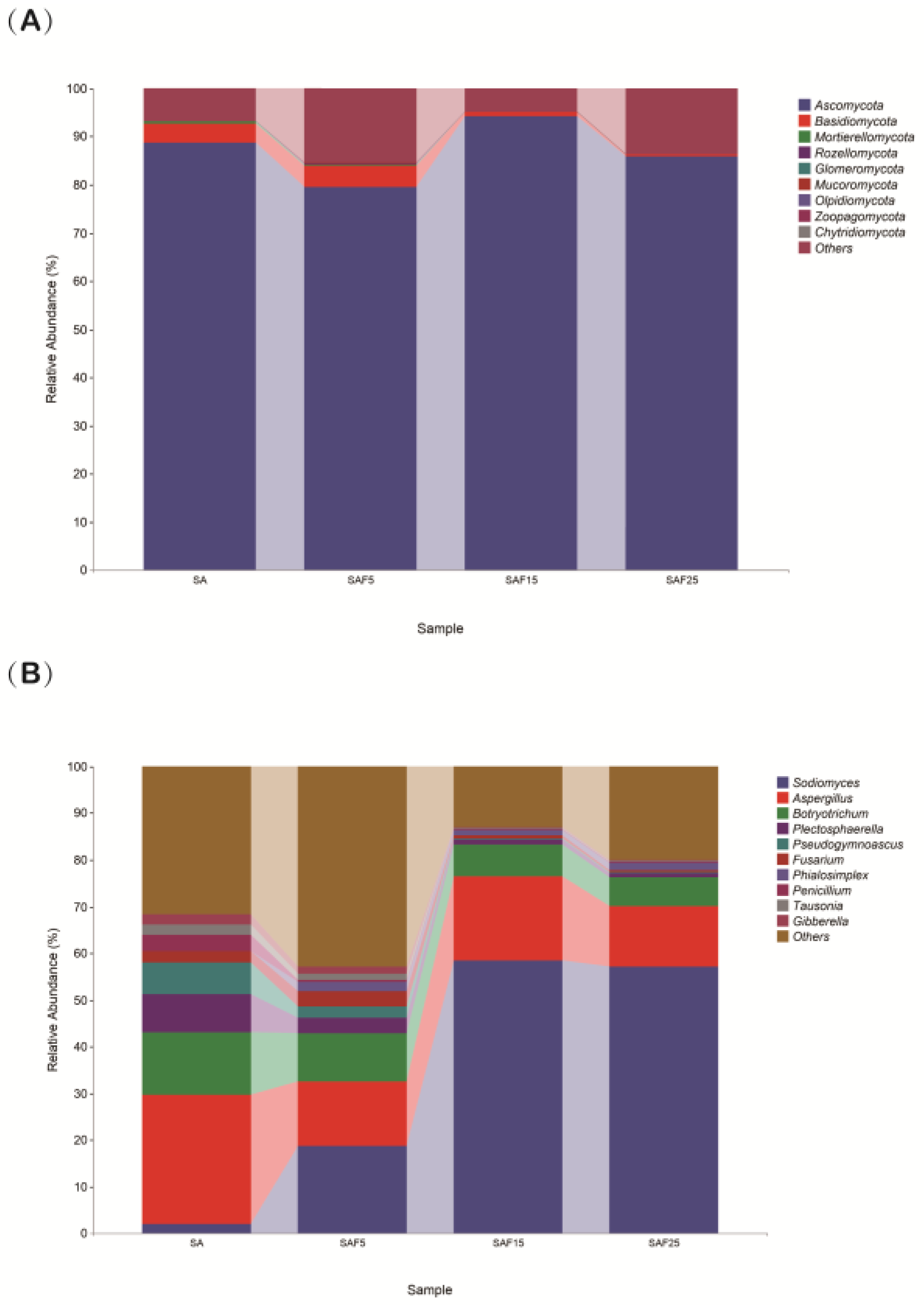
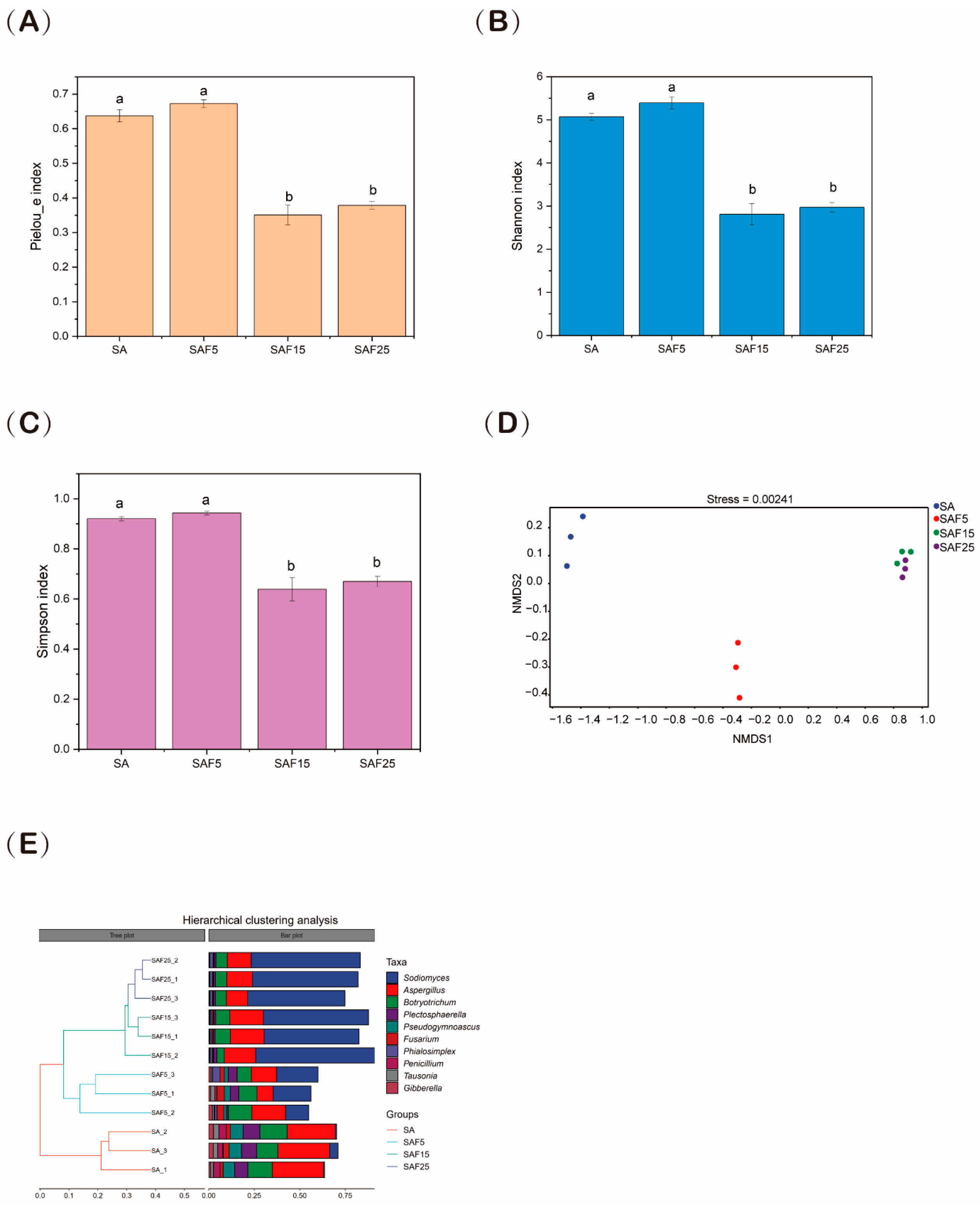

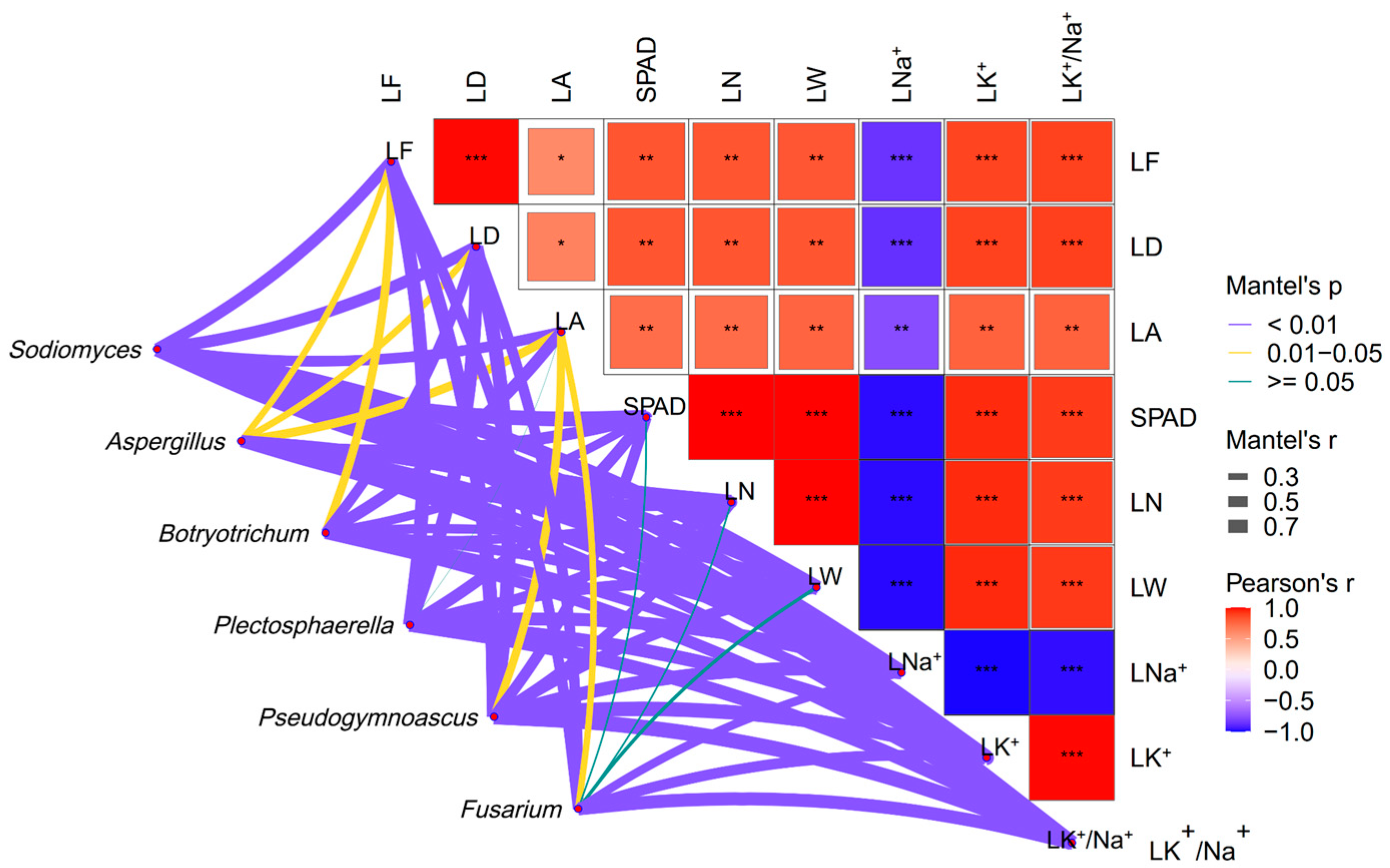
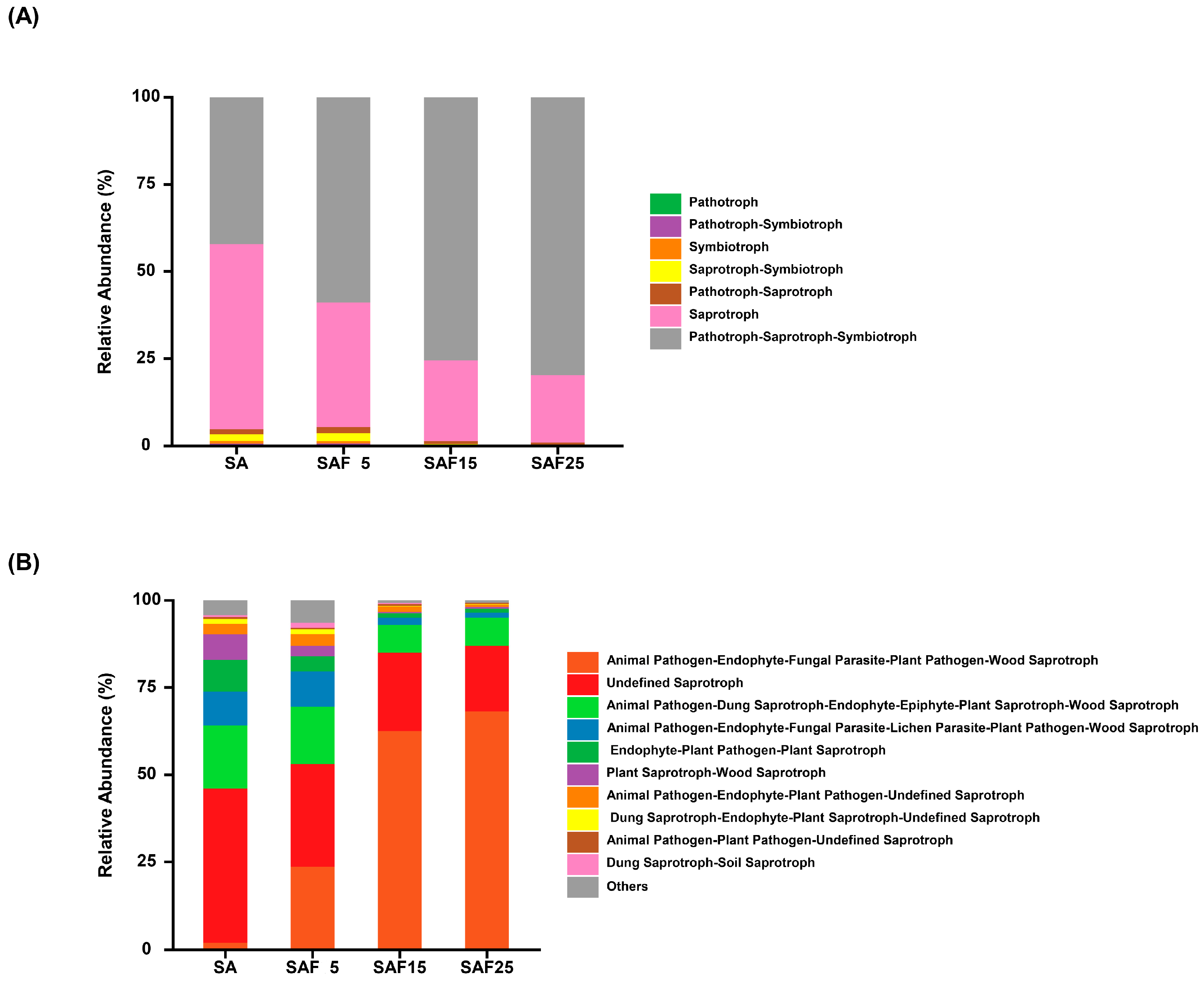
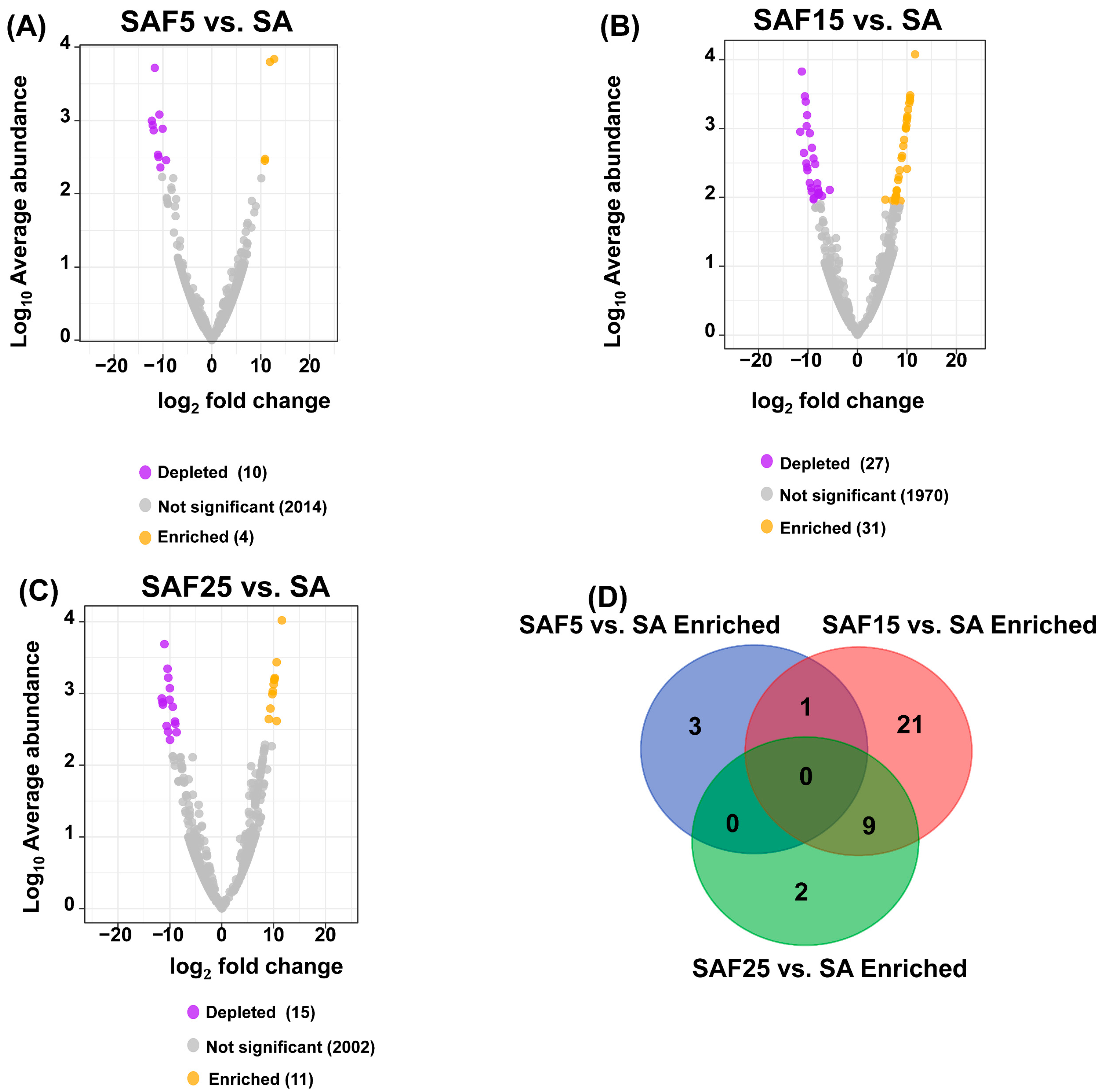
| Treatment | pH | SOC (g kg−1) | TN (g kg−1) | TP (g kg−1) | BGC (U g−1) | URE (U g−1) | APC (nmol−1 d−1 g−1) |
|---|---|---|---|---|---|---|---|
| SA | 9.12 ± 0.04 a | 2.94 ± 0.07 d | 0.37 ± 0.01 d | 0.41 ± 0.00 d | 29.55 ± 0.55 c | 305.76 ± 0.82 d | 5047.15 ± 31.40 d |
| SAF5 | 8.93 ± 0.01 b | 8.84 ± 0.07 c | 0.86 ± 0.02 c | 0.66 ± 0.02 c | 39.45 ± 1.12 a | 587.65 ± 4.28 a | 7519.55 ± 28.22 b |
| SAF15 | 8.48 ± 0.01 c | 18.58 ± 0.14 b | 2.13 ± 0.09 b | 1.18 ± 0.05 b | 34.87 ± 0.58 b | 548.15 ± 6.34 b | 6512.30 ± 52.04 c |
| SAF25 | 8.04 ± 0.01 d | 29.30 ± 0.29 a | 4.29 ± 0.17 a | 1.74 ± 0.08 a | 24.84 ± 0.67 d | 416.05 ± 4.99 c | 7803.25 ± 47.26 a |
| Treatments | LF (g−1) | LD (g−1) | LA (cm2) | SPAD | LN (mg g−1) | LW (%) | LNa+ (mg g−1) | LK+ (mg g−1) | LK+/Na+ |
|---|---|---|---|---|---|---|---|---|---|
| SA | 0.16 ± 0.01 d | 0.03 ± 0.00 d | 1.00 ± 0.07 b | 28.71 ± 0.29 b | 11.75 ± 0.09 b | 46.57 ± 0.19 b | 9.23 ± 0.20 a | 23.28 ± 0.22 d | 2.52 ± 0.03 d |
| SAF5 | 0.32 ± 0.04 c | 0.06 ± 0.01 c | 1.28 ± 0.18 ab | 39.47 ± 0.62 a | 15.15 ± 0.20 a | 60.19 ± 1.17 a | 5.39 ± 0.04 b | 38.72 ± 0.35 c | 7.18 ± 0.02 c |
| SAF15 | 0.62 ± 0.03 a | 0.11 ± 0.00 a | 1.48 ± 0.09 a | 41.17 ± 0.89 a | 15.67 ± 0.28 a | 62.69 ± 1.11 a | 4.12 ± 0.06 c | 46.61 ± 0.30 b | 11.31 ± 0.17 b |
| SAF25 | 0.47 ± 0.02 b | 0.09 ± 0.00 b | 1.50 ± 0.10 a | 40.91 ± 0.65 a | 15.60 ± 0.21 a | 62.40 ± 0.82 a | 3.95 ± 0.44 c | 49.28 ± 0.31 a | 12.49 ± 0.07 a |
Disclaimer/Publisher’s Note: The statements, opinions and data contained in all publications are solely those of the individual author(s) and contributor(s) and not of MDPI and/or the editor(s). MDPI and/or the editor(s) disclaim responsibility for any injury to people or property resulting from any ideas, methods, instructions or products referred to in the content. |
© 2024 by the authors. Licensee MDPI, Basel, Switzerland. This article is an open access article distributed under the terms and conditions of the Creative Commons Attribution (CC BY) license (https://creativecommons.org/licenses/by/4.0/).
Share and Cite
Wei, T.-J.; Li, G.; Cui, Y.-R.; Xie, J.; Liang, Z.-W.; Guan, F.-C.; Li, Z.-H. Response of Alfalfa Leaf Traits and Rhizosphere Fungal Communities to Compost Application in Saline–Sodic Soil. Microorganisms 2024, 12, 2287. https://doi.org/10.3390/microorganisms12112287
Wei T-J, Li G, Cui Y-R, Xie J, Liang Z-W, Guan F-C, Li Z-H. Response of Alfalfa Leaf Traits and Rhizosphere Fungal Communities to Compost Application in Saline–Sodic Soil. Microorganisms. 2024; 12(11):2287. https://doi.org/10.3390/microorganisms12112287
Chicago/Turabian StyleWei, Tian-Jiao, Guang Li, Yan-Ru Cui, Jiao Xie, Zheng-Wei Liang, Fa-Chun Guan, and Zhong-He Li. 2024. "Response of Alfalfa Leaf Traits and Rhizosphere Fungal Communities to Compost Application in Saline–Sodic Soil" Microorganisms 12, no. 11: 2287. https://doi.org/10.3390/microorganisms12112287
APA StyleWei, T.-J., Li, G., Cui, Y.-R., Xie, J., Liang, Z.-W., Guan, F.-C., & Li, Z.-H. (2024). Response of Alfalfa Leaf Traits and Rhizosphere Fungal Communities to Compost Application in Saline–Sodic Soil. Microorganisms, 12(11), 2287. https://doi.org/10.3390/microorganisms12112287





